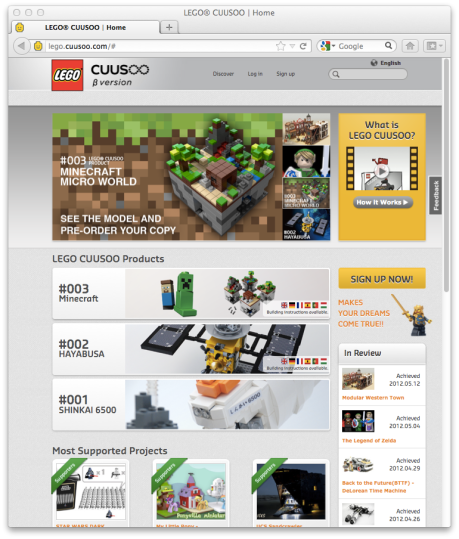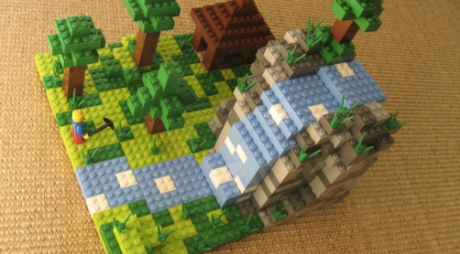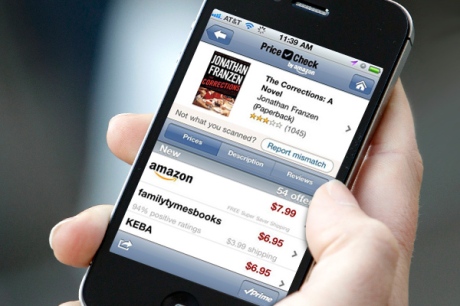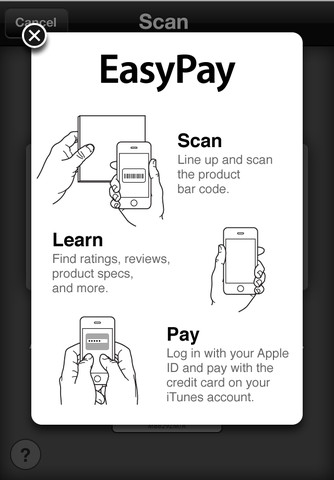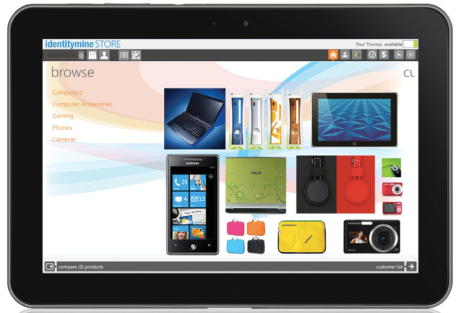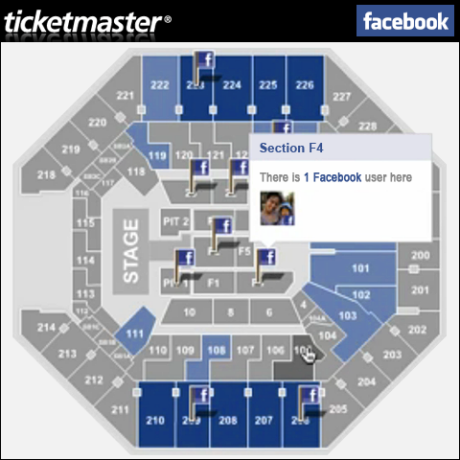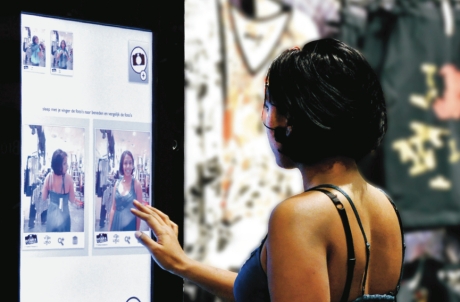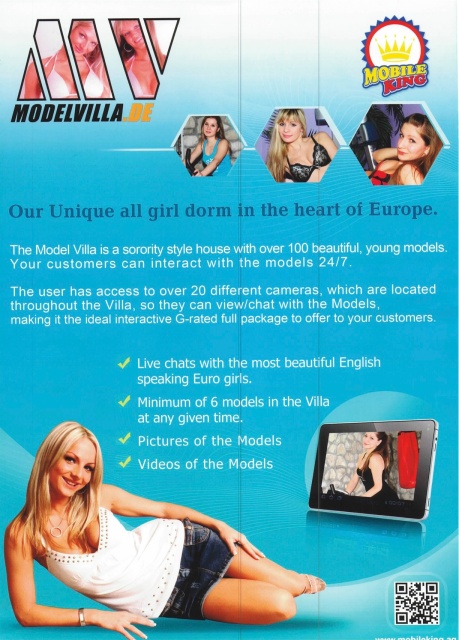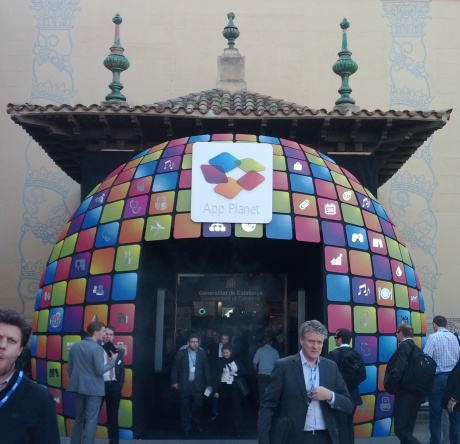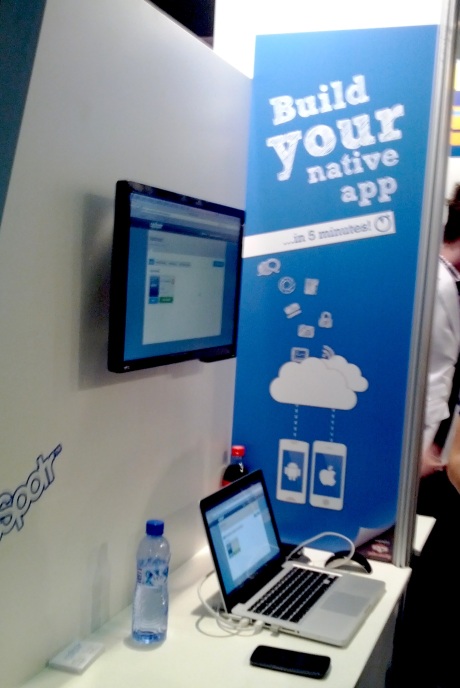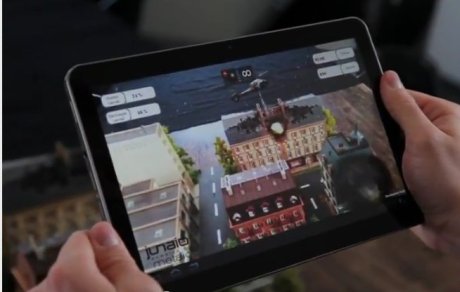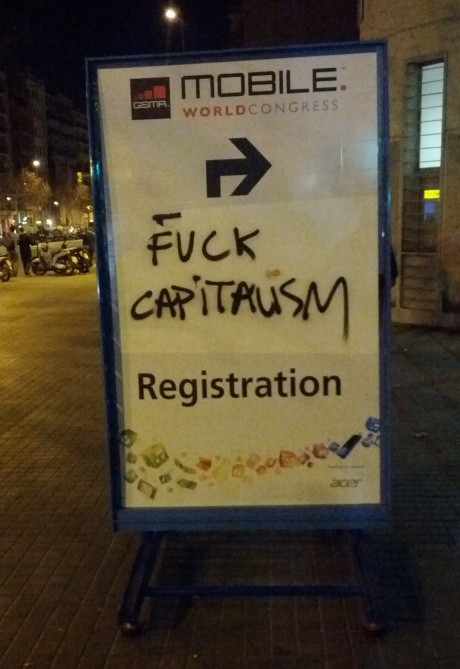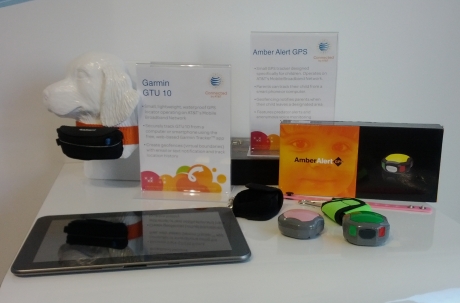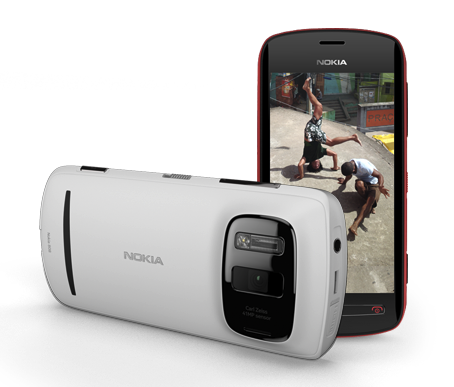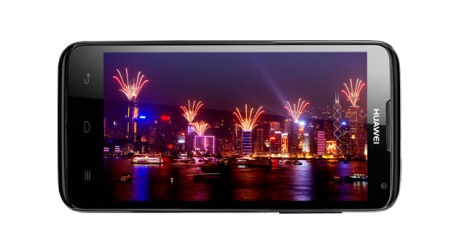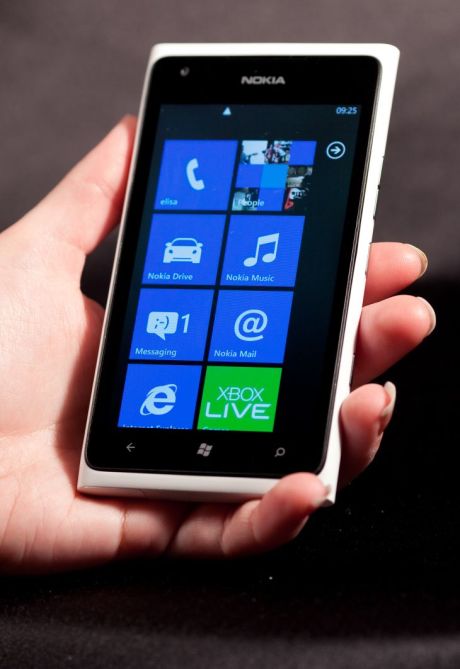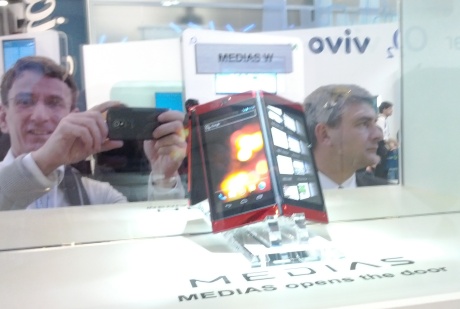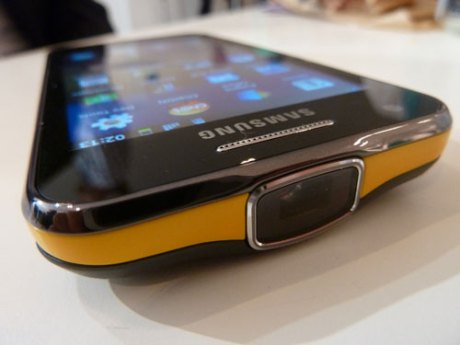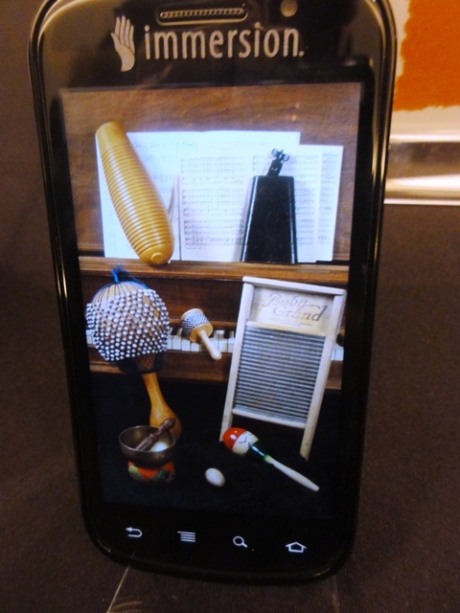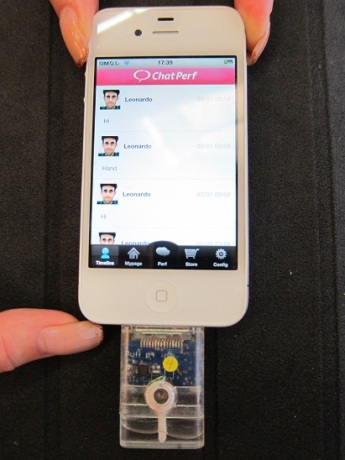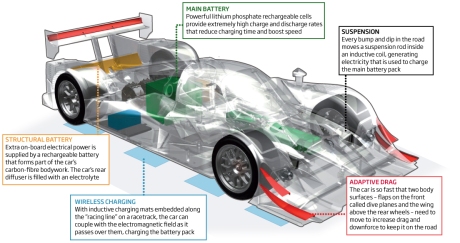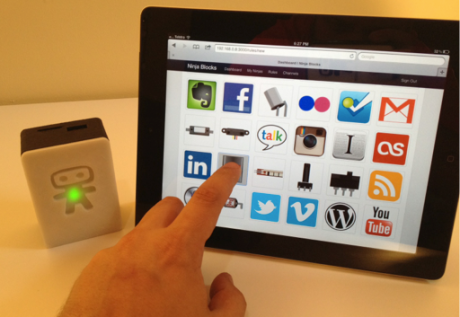Emoticons in Logos :-( May 29, 2012
Posted by reto wettach in making the invisible visible, new technologies, poetic, visual design.3 comments
As some of you know, I am professor with the University of Applied Sciences in Potsdam (FHP). And therefore I have to live with the fact that I work for an institution with an emoticon in their logo:
(image source)(the logo was originally designed by Thomas Manns in 1993; its current version was done by my colleague Matthias Beyrow – his office)
Now I found this sausage stand close to the Reichstag in Berlin:
Well, maybe it is time for my university to rethink its branding…!
PS.: Before writing this post, I talked with Matthias: soon he will be publishing a book on logos for German universities. According to his research the logo of my university is not so bad – compared with others… 🙂
Thoughts on “Cross-Media” May 9, 2012
Posted by reto wettach in innovation process, service design, strategies, theory.1 comment so far
Since 2000 the Berlin senate is organizing a regular panel discussion called “Zukunftsgespräch” (conversation about the future) on innovation in ICT. Yesterday’s 61st Zukunftsgespräch was about “cross-media” and I was on the panel.
Here a summary of my prepared statements, which I discussed with my team at IxDS (sorry only in German):
Ich finde, dass die Definition von Cross Media in der Einladung zu dem heutigen Zukunftsgespräch zu kurz greift: es wird dem Thema und den Potentialen nicht gerecht, wenn wir fernsehserienproduzierenden Verlage als Vorbild zitieren oder von Popsongs reden, die auch als Klingeltöne vertrieben werden – auch wenn wir hier in Berlin im Bereich Klingeltöne eine gewisse Schuld auf uns geladen haben.
Zumal, Cross-Media häufig das Ziel verfolgt (so ist zumindest mein Eindruck), den analogen Nutzer in das Digitale zu holen, wie beispielsweise der ZDF Film, der im Internet weiterläuft, oder QR-Code auf Poster, um Posterbetrachter ins Internet zu locken.
Wir müssen Cross-Media weiter denken und vor allem aus den klassischen Sparten heraustreten und uns auf neue Experimente einlassen. Wir müssen es schaffen, dass die Storytellers und die Technologen zusammen an neuen Formaten arbeiten. Wir müssen die Leser, Fernsehkonsumenten, Kinogeher usw. zum Mitmachen einladen und zum Mitmachen befähigen (empowern – wie man so schön im Englischen sagt).
Und vor allem müssen Magische Momente kreieren – magisch im Sinne von Arthur C. Clarke, der so schön festgestellt hat, dass „Jede hinreichend fortschrittliche Technologie von Magie nicht zu unterscheiden“ ist.
Konkret sehe ich drei Bereiche, wo spannende Herausforderungen im Bereich Cross-Media vor uns liegen:
- Visualisierung: Unsere Umwelt ist geprägt von komplizierten Prozessen, von komplexen Zusammenhängen, von riesigen, frei verfügbaren Datenmengen. Wie können wir – eventuell gemeinsam mit den „Nutzern“ – diese Daten zu relevanten Wissen, gar Weisheit werden lassen. Für mich gehört es zu den medialen Aufgaben, z.B. die Prozesse/Transaktionen/Zusammenhänge in der Politik (z.B. EU), in der Wirtschaft (z.B. Bankenrettung) oder in Globalisierung (z.B. Umweltschutz) erfahrbar werden zu lassen. Der mündige Bürger soll eigenständigen diese Daten auslegen dürfen und dafür bedarf es neuer crossmedialer Produkte.
- Raus in den Raum, in die Umwelt: Noch sind wir relativ statisch in unserem Medienangebot – wir gehen von einer Person aus, die sich hinsetzt, um Medien zu konsumieren. Das ändert sich gerade massiv: Wir sind unterwegs, an bestimmten Orten, in bestimmten Kontexten, wir sind mal aktiv, mal passiv, mal dazwischen, unsere Umgebung fängt an auf uns zu reagieren, usw
Als Beispiele seien die wunderbare Arbeit von Rimini-Protokoll, dem „Walk-In Stasi Radio Play“ (2011), die unter dem Umbrella „Location Based Services“ – oder besser noch: „Location Based Storytelling“ – fallen.
Eine andere Kategorie von Cross-Media sind Stories, die in die Architektur, in den urbanen Raum verortet sind. Natalie Jeremijenko hat 2009 das Projekt „Amphibious Architecture“ realisiert, wo auf dem Wasser schwebende, leuchtende Glasröhrchen eine Geschichte zur Wasserqualität erzählen. - Die Einbeziehung des „kreativen Konsumenten“: das fängt mit dem Suchen und Finden an, passiert beim „Kreieren“ des Medienprodukts, natürlich beim „Konsumieren“ (wobei sich die Frage stellt, wo das eine aufhört und das andere anfängt), und geht meiner Meinung nach mit dem Ende der Geschichte weiter. Für mich gehören all diese Aspekte auch in die Gestaltung des Formates – und sollten nicht getrennt davon gedacht werden (ein kleiner Seitenhieb an die Social-Marketing-Experten). Wir sprechen hier von Co-Creation, also die gemeinsame Entwicklung von Inhalten, von Erfahrungen mit den Endnutzern. So gibt es beispielsweise Ricardo Bomba, ein Charakter bei den Simpson, der von den Fans kreiert wurde. Wobei hier angemerkt werden soll, dass Co-Creation auch sehr klein sein kann: auch schon die Verlinkung, Einsortierung oder Kommentierung von Inhalten ist ein kreativer Akt!
Die Forderung nach Beteiligung hat übrigens auch Implikationen auf die Organisation von Firmen, also von “Verlagen” wie sie früher hießen, die im Cross-Media-Bereich tätig sind.
Cross Media verlangt Forschung!
- In Formate
Auf die Formate bin ich ja schon eingeganen. Vielleicht nur so viel: Aus dem Interaction Design wissen wir, dass es sehr schwierig ist, a priori, also rein planerisch über die Qualität eines Entwurfes zu urteilen. Interaktive Erfahrungen, wie wir sie gestalten, sind in der Tat sehr komplex, haben unendlich viele Stellschrauben und häufig ist sind es die Ausführungen im Detail, die über Akzeptanz, über Freude am Nutzen, über Erfolg entscheiden. Daher abreiten wir sehr intensiv mit Prototypen, Prototypen in jeder Phase einer Entwicklung. Und heute kann man sehr viel schon sehr günstig prototypisch umsetzen. - In Tools
Diese Aufgabe halte ich für enorm wichtig: wir müssen selbst die Tools entwickeln, auch die IT-basierten Tools für Cross-Media, und wir müssen sie der Allgemeinheit zur Verfügung stellen. Die, die wirklich erfolgreich sind im Medienbusiness (Instagram, Berlins Music-Softwarefirmen usw) sind die Tool-Anbieter. - In den Vertieb: Hier denke ich muss und wird noch viel passieren. Es zeigt sich am Horizont, dass auch im Internet verstanden wurde, dass nicht alles umsonst ist. Selbstverständlich gibt es Gründe, kostenfrei zu publizieren, aber es muss auch Gründe (und Möglichkeiten) geben, mit Inhalten Geld zu verdienen! Verschiedene Business Modelle fangen an, sich zu etablieren, müssen aber weiterentwickelt werden. Beispiele: Kick-Starter für Buch- oder Filmprojekte, InApp-Verkäufe (aus Spielen) für mediale Inhalte (z.B. Koch-App von Jamie Olivier), Spotify, Flattr
MWC 2012 – Women March 13, 2012
Posted by reto wettach in poetic.add a comment
Well, the Mobile World Congress is kind of a very techy-businessy event – with lots of men in their traditional uniform of white shirt and suit.
Of course in such an environment, some products do tell a lot about the phantasies of these men, or at least of some of them:
The iPad Receptionist is a concept from Japan: the idea is that you install an iPad at your front-desk or at the bell. Visitors can then interact with this wonderful lady:
(by Analog12)
Even stranger is a similar concept of Virtual Assistant by Narada Robotics from Spain, a projection of a lady, which the user interacts with through voice. Interesting is that the screen, where the lady is projected to, has the shape of a lady. They advertise with the “closeness feel” to the user-client interaction (source):
(by Narada Robotics)
Last but not least a service also offered at the MWC: Modellvilla by MobileKing is a “sorority style house with over 100 beautiful, young models”. The users can interact with these girls “24/7”:
Well, I am happy that I am not the psychologist you has to interpret these offers…
MWC 2012 – Software March 13, 2012
Posted by reto wettach in exhibitions, mobile, new technologies.add a comment
Second part of my MWC-Report:
The App-Planet was not at all what its name promised – in fact, there were hardly any apps being shown at this year’s MWC. Talking to my colleague Johannes Landstorfer we assume that this is related to the fact that today more and more app vendor do not have to sell through the large telcos, but through the app stores directly to the customer.
As Apple did not participate, the MWC felt like a big Android party – (sorry guys at Nokia…)
(own video)
Actually, the only booth, which showed Apps, was Android.However, for somebody in the field, it was not really exciting. The presentation also lacked any form of excitement: no new releases etc:

(own image; I am not sure, why Google presented this material exploration wall, as nothing is less haptic than the smartphone world…)
A large part of the software offerings were related to easy-creation and easy-portation of apps:
iTude is one of these companies. They have a good description of why they do what they do: Mobile apps are coming of age. Simple brand presence apps no longer captivate consumers. Consumers expect mobile apps to have the same functions as online services. At the same time, companies are struggling to catch up with developments in mobile apps. Lulled by a decade of stable internet technology, they now find it hard to adapt to the fast changing mobile world. iTUDE has developed mobile apps and mobile websites since 2006 and has a proven track record of professional, successful apps and websites. (source)
AppSpotr was one of these service providers: their claim at MWC was: “Build your native app in 5 minutes”.
Their apps run on iPhone and Android and can be update “anytime, anywhere for everyday changes.”
Additionally to the easy-development of simple apps, specialized easy-to-use app kits were presented:
AR was very prominent amongst these specialized kits. The best I saw was Metaio, a software, which could recognize and augment (in real time) 3.d-situations. The demo was a model city, where augmented fires started a various buildings. This technology could be very interesting for a lot of use cases, unfortunately most AR-applications presented at MWC were around augmenting ads, packages or magazines…
Ads seems to be the driving force in a lot of offerings at the MWC:
Smaato is offering the integration of ad in your apps.
Mobile Marketing was also a huge topic, even though I never really understood, what it is. I guess these companies make it very easy to send out your message via all available mobile chanels, be it SMS, Bluetooth, App or Websites. CyTech is such a company.
MWC 2012 – Hardware March 12, 2012
Posted by reto wettach in gadgets, light, mobile, physical interaction design.add a comment
Here my personal report on the Mobile World Congress this year in Barcelona:
1. Even though by the end of 2012, the number of mobile-connected devices will exceed the number of people on earth (according to Cisco), M2M is still just for the industry: None of the exhibitors understood that M2M (Machine-to-Machine or ‘Internet of Things’) could be an interesting field for inventors, startups and small or medium sized companies. All the ready-to-use-technologies that I saw were pretty heavily directed towards engineers – at not (as with Arduino or Fritzing) towards the community of creatives.
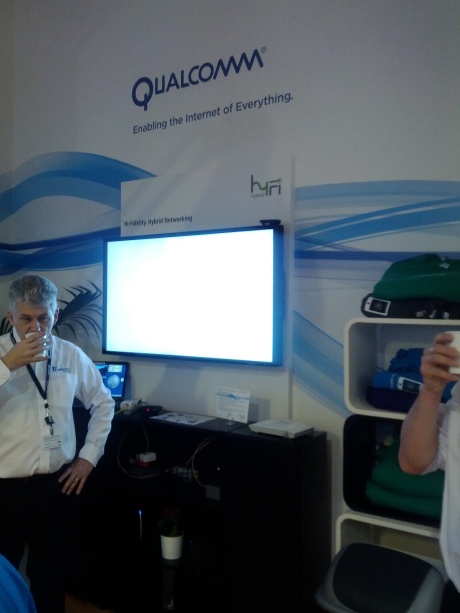
(own image – excuse the quality)
Of course one can find the good old use-cases as home-network, health and car, and very little applied and innovative M2M-products. So, you can imagine how happy I was when I saw Glowcab by my friend David Rose. Next to his product, At&T showed Garmin GTU, a pet GPS–tracker, and Amber Alert GPS, the same for kids:
2. Mobile phones are getting boring – just more of this and more of that:
– More Pixels
Even though the 41-Megapixels offered by Nokia 808 PureView are not meant to be stored directly, but to improve the quality of the images, I just want to show that it is all the same, but more in the details.
– More Computing Power
It has been long time that I got excited about the performance of computers – but at MWC this topic was – as expected – huge. Wow, a quad core 1,5GHz mobile phone – please show me, for what we can use all this speed!!!
– More Design
The mobile phone industry decided to go down the lane of the wonderful black monolith (known form the movie “2001: A Space Odyssey”) – and now some of the major players are trying to add some design to this object:
Nokia is very proud of the “one-piece polycarbonate body”, which comes in various colors. For me it rather looks like an unnecessary add-on:
Sony shows with its Xperia U another mobile phone with an interesting feature, similar to Philips AmbiLight from 2002: the transparent bar is illuminated and “echoes” the major color currently on the screen. I couldn’t find out, why – besided on looking different…:
(view at 0:43)
Medias, the mobile phone brand of NEC, is showing a double-screen-smartphone “Medias W”. Well, “pixel everywhere” – who knows, maybe we will be seeing it one day in real live!
– Finally: Mobile with Projector
IxDS, the company where I work with, did already in 2008 a project on exploring the potential of pico-projectors in mobile context. We came up with a couple of ideas and concept, none strong enough to make our client launch such a product right away. But now, Samsung came up with Galaxy Beam. A long line of visitors had to wait to experience this device in the dark-room. I was rather disappointed as the use-cases were nothing special: projecting slides from a presentation, home made videos or downloaded stuff…
3. Mobile Sensing – still exciting!
Just one example – to not turn too nerdy here: ST Microelectronics presented a 10-axis-accelerometer-board. I first was not sure for what this should be good (another tilting-based game) until they explained to me that with this technology, they can “determine location reliably to within a few metres even in the absence of GNSS (Global Navigation Satellite Systems) satellite signals.” (source) – which is good for indoor location tracking. Wow!
4. Mobile Actuation – there’s hope…
I finally had the chance to meet some guys from Immersion: they were displaying their “HD Haptics“, which was pretty impressive: Their demo was a selection of musical instruments on a touch screen, you choose one and then shake the mobile and can really feel the instrument. It is hard to describe, but it really gives me hope for richer tactile interaction. Technologywise, the system is based on piezo – I guess similar to my friend Ivan Poupyrev’s touch engine from 2002.
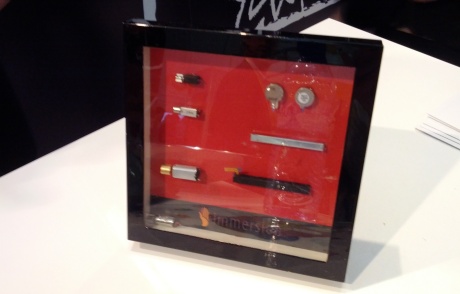
(own image)
Well, another interesting approach to mobile actuation was presented by the Japanese company ChatPerf. They propose an mobile actuator, which sprays perfume:
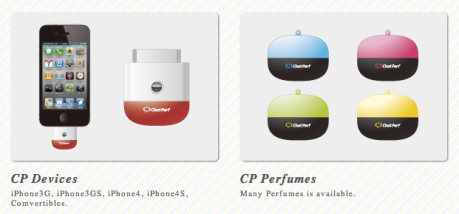
(image source)
Currently they only have a prototype:
5. Body!
Well, there was very little real “Physical Interaction” at the MWC – more or less as expected. So it was nice to meet the friends from Oblong Industries: they presented their new intuite interaction tool called Mezzanine:
Design Tool Design February 23, 2012
Posted by reto wettach in prototyping tools.add a comment
Bret Victor, a designer who worked amongst others for Apple and Al Gore, talks about creativity and tools and has some important principles he follows when developing his tools:
“Creators need an immediate connection to what they are creating.”
He means by this that – while creating – changes has been experienced immediately. I agree on that: in art and design this is called “thinking within the material”. Bret says that “so much creation is discovery – and you can’t discover anything if you cannot see what you are doing!”
Applied to software developement, Bret is criticizing that coding (aka writing text into a text editor) is disconnected from the result. One works “blindly” in the text editor – “without an immediate connection” to the result.
Instead Bret is suggesting a system, where result and code are next to each other, and where changes in the code affect the result immediately. These changes can be done by typing of by a slider, which allows to change values dynamically:
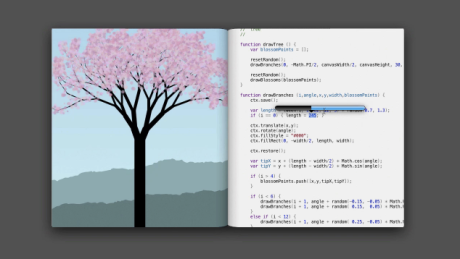
(image source 3:46)
This is programming philosophy is also working for dynamic results as computer games and for complex programming algorithms!
Bret is applying his design principle also to electronic design – based on simulation:
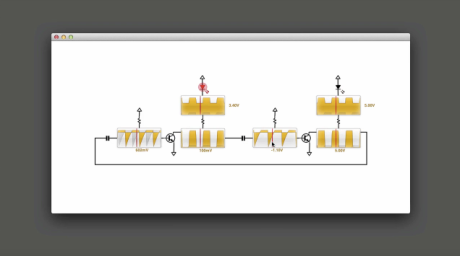
(image source, 25:59 – with the mouse one can change the current)
I am a little surprised that – for design of analog electronics – Bret is talking about the simulation – even though they look wonderful and convincing for the chosen example. I would think that his principle applied to design of electronic circuits would be rather based on doing the real thing than playing with a simulator…
Regarding Fritzing, I am wondering what this philosophy would mean. I guess the first step would be to have more transparent programming environment for micro controllers, which not only allows the modification of values and code in real time, but also give feedback on every single piece of information available, be it on value of datatypes or on current situations at various ports. In a next step it would be interesting to develop certain electronic components, which can change their behavior dynamically (as a resistor).
Great talk!
Charging your e-Car while Driving February 23, 2012
Posted by reto wettach in new technologies, physical interaction design, sustainable interaction design.add a comment
One of the big project we at IxDS did last year was about the user experience of owning an e-car. Of course the charging (and the fear of running out of energy) were important aspects of our design research.
Today, I found an interesting concept for a racing car described in the NewScientist: most exciting to me is the idea of charging the car while driving. Based on the wireless charging technology developed by HaloIPT, the idea of the concept car is to embed this technology in the racing track:
Drayson wants to populate the racing line on racetracks with the pads, so cars charge from the track during races.
Imagine, what this means for the user experience!!!
M2M for very beginners February 17, 2012
Posted by reto wettach in gadgets, new technologies, physical interaction design, prototyping tools.3 comments
As I wrote a couple of months ago, I am currently preparing a new research project which focusses on the easy access for non-engineers to the so called “Internet of Things”-technology.
The other day I stumbled over a wonderful project called “Ninja Blocks“. This is basically a piece of open source hardware, which can easily be connected to the internet and allows basically anybody to set up simple rules based on “triggers” and “actions”:
Example Triggers:
“Movement has been detected”
“The temperature has risen above”
“You’ve been tagged in a photo on Facebook”
“You’ve sent a new tweet”
“A button has been pushed”
“Sound is detected”
“Your friend has checked in”
Example Actions:
“Display text on an LCD display”
“Play a sound”
“Send a tweet”
“Open a relay”
“Turn on a light”
“Send an SMS to my phone”
“Post a message on Facebook”
(source)
What a great idea!
The block itself contains an RGB LED, a built-in temperature sensor and an accelerometer, four expansion ports and a regular USB port allow you to add further inputs and outputs.
The basic design philosophy follows quite a high-level approach, not comparable to Arduino. I guess that is the way to go: though this kind of plug&play approach even more people will be attracted to work creativily with hardware.
All the best for your kick-starter initiative, Ninja Blocks!


